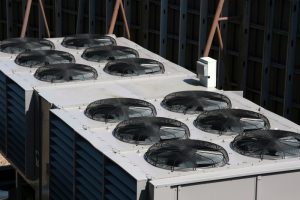One of the most important parts of installing new commercial and industrial HVAC equipment is sizing it. To people unfamiliar with HVAC terms, this may sound like trying to determine the right physical size of the equipment.
But the “sizing” we’re referring to is the capacity of the unit to provide either heating or cooling (often both in the case of packaged rooftop units).
This sizing needs to take into account numerous factors about the facility.
When you schedule commercial or industrial HVAC installations/replacements with our expert technicians, they’ll go through several steps to size the new equipment so that it matches your facility’s requirements. Undersizing or oversizing equipment will result in inefficient performance and early unit failures.
The Tonnage of an HVAC Unit
When we size a new HVAC unit, what we’re looking for is the correct tonnage. Tonnage is a measurement of the heat that a heater adds to a space or an air conditioner removes from a space.
One ton is equal to 12,000 BTUs (British Thermal Units), which is a convenient measurement when it comes to HVAC equipment.
Why is this unit called a ton? Because 12,000 BTUs is the amount of heat necessary to melt one ton of ice over 24 hours.
To give you a sense of general sizing, most residential HVAC systems are between 1 to 5 tons. Light commercial systems are up to 25 tons, and anything over that is considered heavy commercial or industrial.
How Tonnage is Determined
Is it possible to figure out how many tons of heating/cooling your facility needs on your own? You can get a general estimate based on square footage, but this isn’t accurate enough, especially when you consider what’s on the line.
It takes professionals to figure out the tonnage through a process called a load calculation. During a load calculation, the HVAC technicians consider many factors about the facility: square footage, heat given off by equipment, ventilation requirements, building heat loss and gain, temperatures necessary for equipment and process, etc.
The calculations are different for every facility. At the end of the load calculation, the technicians will know the tonnage necessary for the new installations.
Why Sizing Must Be Correct
Reading over this, you might wonder what could go wrong if equipment is improperly sized during installation. Both oversizing and undersizing are problems:
- Undersized: The equipment will not be able to meet temperature requirements and will run continually, wasting power and rapidly running down.
- Oversized: The equipment will change the temperature so rapidly that it will shut down before completing a full cycle. It will then begin to rapidly cycle on and off, a condition called short-cycling that drains immense amounts of power and will lead to early repairs and replacement.
We want to make sure you have the best possible industrial/commercial air conditioning and heating installation in Toronto, ON. Our approach is customized to each of our clients.
Advantage Airtech Commercial Ltd. is the Double “A” Name with the Triple “A” Rating. Schedule commercial and industrial HVAC installations with us today.


